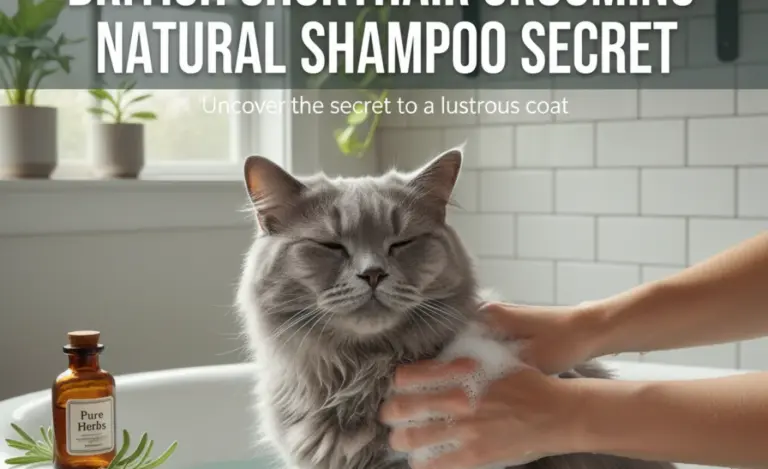Best Practices for Cat Nail Trimming: Easy Guide
Trimming your cat’s nails regularly is essential for their health and your safety! Use cat-specific clippers, create a calm environment, and gently clip only the sharp tips, avoiding the quick (the pink part with blood vessels). Reward your cat with treats and praise to make the experience positive. If you’re unsure, ask your vet or a groomer for help.
Is your beloved British Shorthair using your furniture as a scratching post? Or perhaps their playful kneading is becoming a bit too sharp for your liking? Don’t worry; you’re not alone! Many cat owners find nail trimming a bit daunting. But with the right approach, it can be a stress-free experience for both you and your feline friend. I’m Frances, and I’m here to guide you through the best practices for cat nail trimming, ensuring your kitty’s paws are purr-fectly maintained. Let’s get started!
Why Trim Your Cat’s Nails?
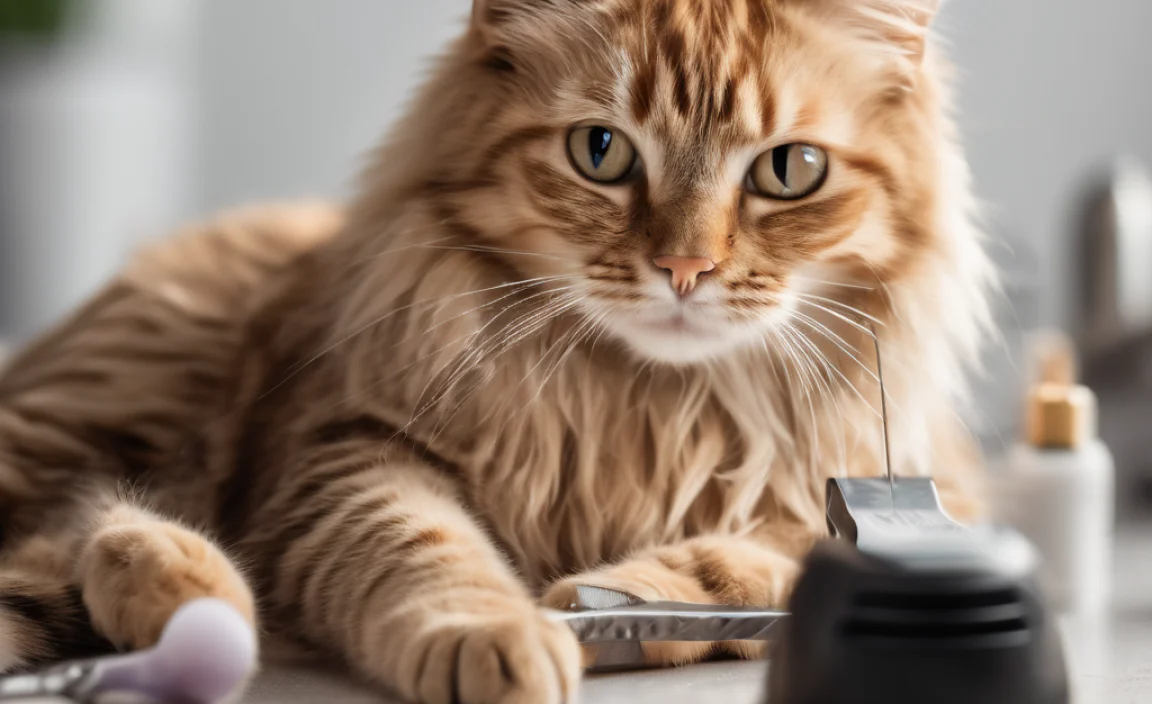
Trimming your cat’s nails is more than just a cosmetic procedure; it’s crucial for their well-being and your household’s safety. Here’s why:
- Protects Furniture: Regular trimming prevents your cat from excessively scratching furniture, carpets, and curtains.
- Prevents Injury: Overgrown nails can get caught in carpets or fabrics, leading to painful injuries or infections.
- Reduces Scratching Damage: Trimming minimizes the damage caused by scratching, especially important if you have children or delicate skin.
- Maintains Hygiene: Shorter nails are easier to keep clean, reducing the risk of bacterial infections.
- Comfort for Your Cat: Untrimmed nails can curve and grow into the paw pads, causing significant discomfort and pain.
When to Start Trimming Your Cat’s Nails
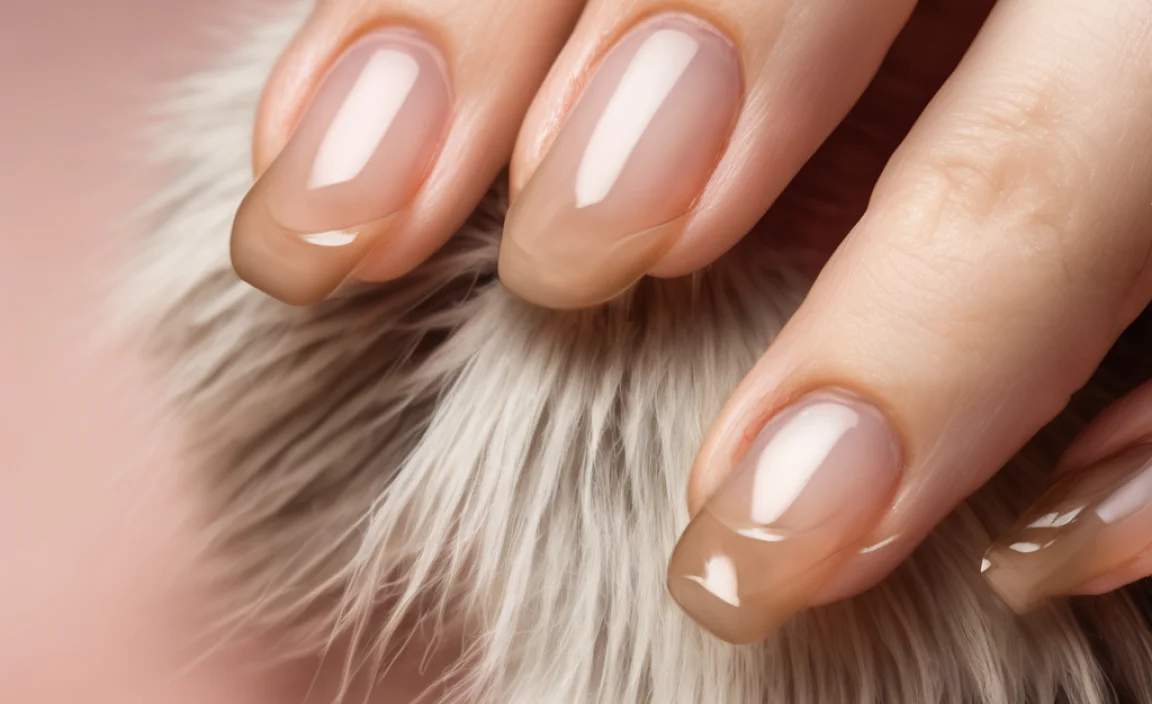
Ideally, start trimming your cat’s nails when they are kittens to get them accustomed to the process. However, even if your cat is older, you can still introduce nail trimming gradually. The key is patience and positive reinforcement.
Tools You’ll Need
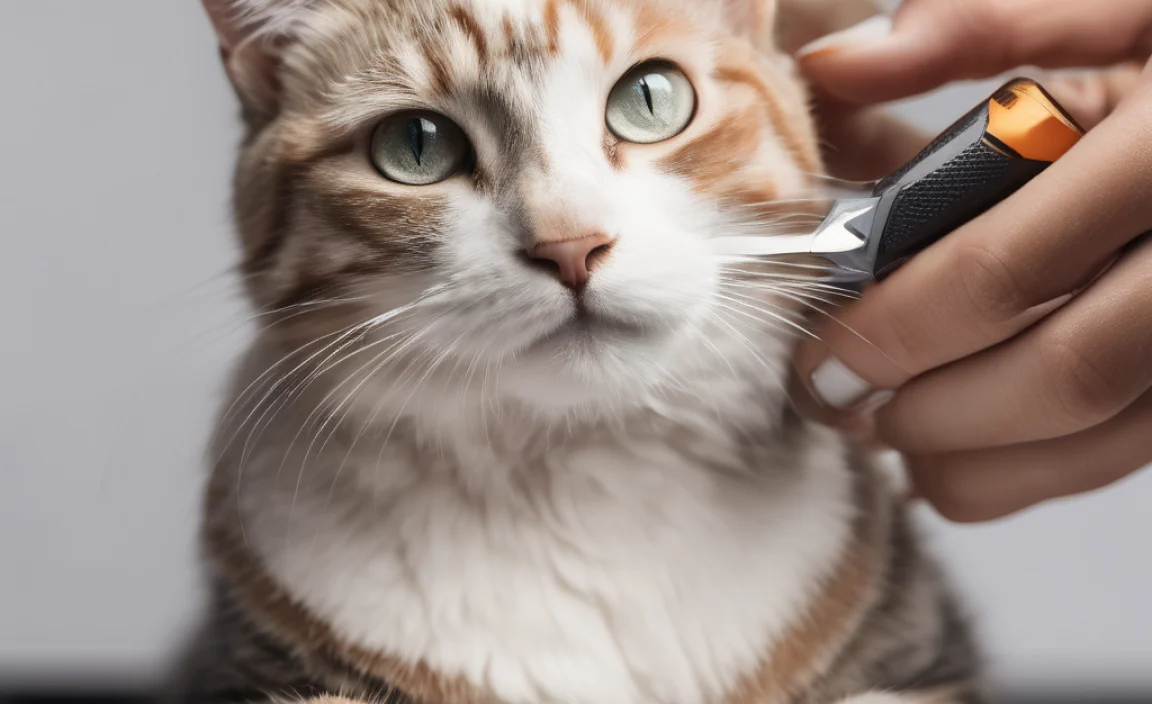
Before you begin, gather the necessary tools to make the process smooth and efficient:
- Cat Nail Clippers: Choose either scissor-style or guillotine-style clippers designed specifically for cats. Scissor-style clippers offer better visibility.
- Styptic Powder: Keep styptic powder on hand to stop bleeding if you accidentally cut the quick (the pink part of the nail containing blood vessels and nerves).
- Treats: Have your cat’s favorite treats ready to reward them during and after the nail trimming session.
- Towel (Optional): Some cats are more comfortable being gently wrapped in a towel.
Step-by-Step Guide to Trimming Your Cat’s Nails
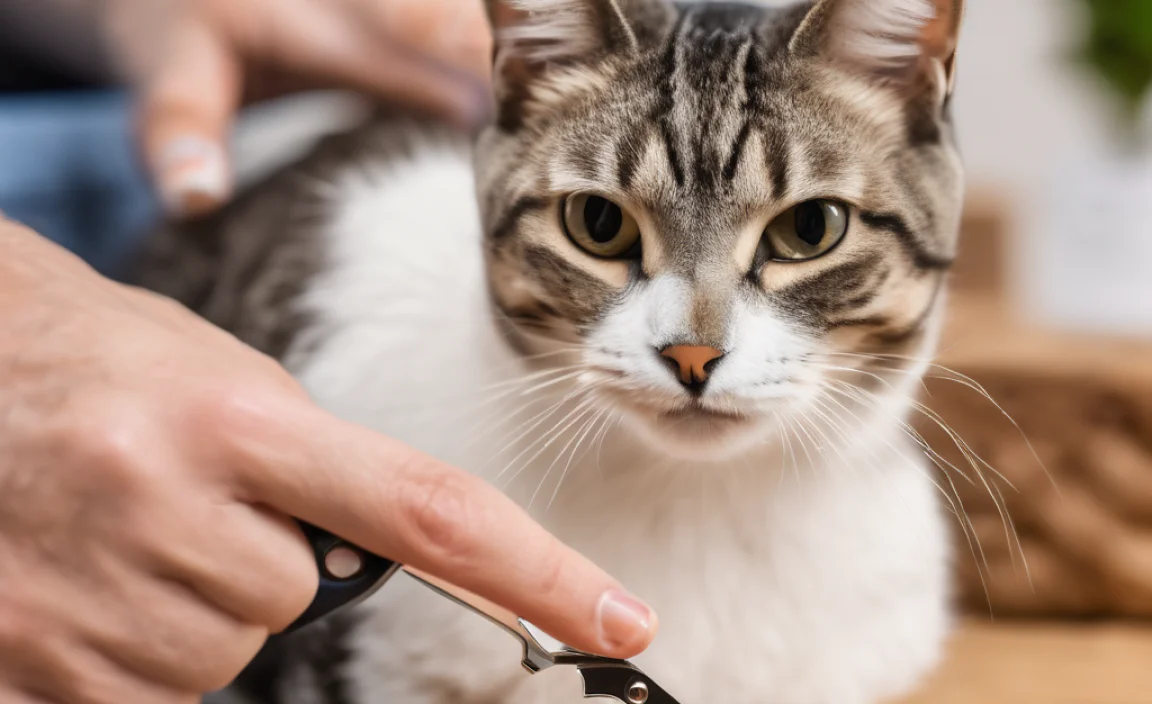
Follow these steps to trim your cat’s nails safely and effectively:
Step 1: Create a Calm Environment
Choose a quiet time and place where your cat feels relaxed. Avoid trimming nails when your cat is already stressed or agitated. A calm environment will make the experience less stressful for both of you.
Step 2: Get Your Cat Comfortable
Gently hold your cat on your lap or place them on a comfortable surface. Pet them and speak in a soothing voice. If your cat is resistant, try wrapping them loosely in a towel, leaving only one paw exposed.
Step 3: Extend the Paw
Gently press the top and bottom of your cat’s paw to extend the claws. This will expose the nails for trimming. Be gentle and avoid squeezing too hard.
Step 4: Identify the Quick
Examine each nail carefully. The quick is the pink part of the nail that contains blood vessels and nerves. You want to avoid cutting this area, as it will cause pain and bleeding. In cats with dark nails, it may be harder to see the quick, so err on the side of caution and trim conservatively.
Step 5: Trim the Nail
Using your cat nail clippers, clip only the sharp tip of the nail, about 1-2 millimeters from the quick. Cut the nail at a slight angle, following the natural curve of the nail. Make a clean, confident cut to avoid splintering.
Step 6: Reward Your Cat
After trimming a few nails (or even just one if your cat is particularly anxious), reward them with a treat and praise. This positive reinforcement will help them associate nail trimming with a positive experience.
Step 7: Repeat the Process
Continue trimming each nail, one at a time, rewarding your cat after each successful clip. If your cat becomes too stressed, stop and try again later. It’s better to trim a few nails at a time than to force the issue and create a negative association.
Step 8: Handle Accidents
If you accidentally cut the quick, don’t panic! Apply styptic powder to the bleeding nail. The bleeding should stop quickly. Comfort your cat and offer reassurance.
Tips for a Stress-Free Nail Trimming Experience
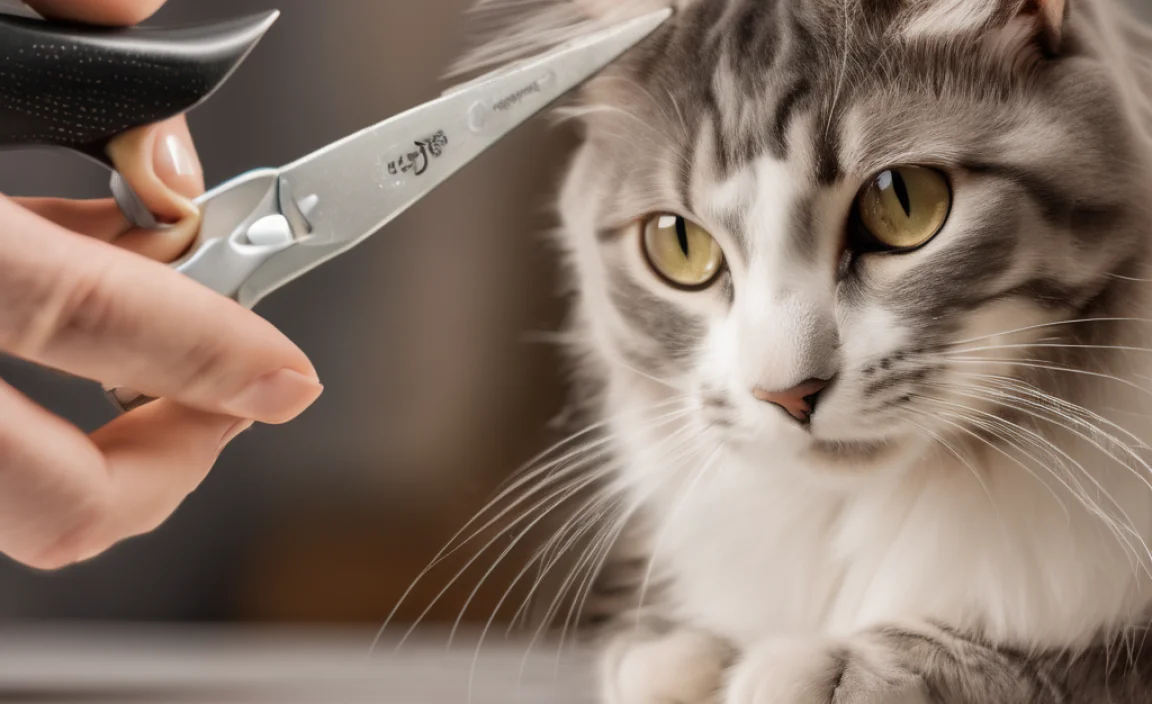
Here are some additional tips to make nail trimming easier:
- Start Young: Introduce nail trimming to your cat as a kitten to get them used to the process early on.
- Regularly Handle Paws: Get your cat accustomed to having their paws handled by gently massaging them regularly.
- Use Positive Reinforcement: Reward your cat with treats, praise, and playtime after each nail trimming session.
- Trim in a Quiet Place: Choose a calm, quiet environment where your cat feels safe and secure.
- Take Breaks: If your cat becomes stressed, take a break and try again later.
- Consider Professional Help: If you’re uncomfortable trimming your cat’s nails yourself, consult with a veterinarian or professional groomer.
Choosing the Right Clippers
Selecting the right type of clippers can make a big difference. Here’s a comparison:
| Type of Clipper | Pros | Cons |
|---|---|---|
| Scissor-Style Clippers |
|
|
| Guillotine-Style Clippers |
|
|
Frequency of Nail Trimming
How often you need to trim your cat’s nails depends on their lifestyle and activity level. Indoor cats typically need their nails trimmed every 2-3 weeks, while outdoor cats may need it less frequently, as their nails wear down naturally. Check your cat’s nails regularly and trim them when they start to become sharp or overgrown.
Dealing with Difficult Cats
Some cats are naturally more resistant to nail trimming than others. If your cat is particularly difficult, here are some strategies to try:
- Desensitization: Gradually introduce your cat to the clippers by simply showing them and giving them a treat. Over time, progress to touching their paws with the clippers without actually trimming.
- Towel Wrap: Gently wrap your cat in a towel, leaving only one paw exposed. This can help restrain them and make them feel more secure.
- Partner Assistance: Enlist the help of a friend or family member to hold your cat while you trim their nails.
- Veterinary Assistance: If all else fails, consult with your veterinarian. They can trim your cat’s nails for you or recommend a sedative to help them relax during the process.
Understanding Cat Scratching Behavior
Scratching is a natural and essential behavior for cats. It allows them to:
- Maintain Nail Health: Scratching helps remove the dead outer layer of their nails.
- Mark Territory: Cats have scent glands in their paws, and scratching leaves a visual and olfactory message for other cats.
- Stretch Muscles: Scratching allows cats to stretch and exercise their muscles.
- Relieve Stress: Scratching can be a way for cats to release pent-up energy or anxiety.
Providing your cat with appropriate scratching posts and surfaces can help redirect their scratching behavior away from your furniture. Make sure the scratching post is tall enough for your cat to fully stretch and made of a material they enjoy, such as sisal, cardboard, or carpet.
Alternative Solutions to Nail Trimming
If you’re still struggling with nail trimming, there are alternative solutions to consider:
- Nail Caps: These are small plastic caps that are glued onto your cat’s nails. They prevent scratching damage without interfering with your cat’s natural scratching behavior. Nail caps typically last for 4-6 weeks and need to be reapplied as the nails grow.
Always consult with your veterinarian before using nail caps to ensure they are appropriate for your cat.
The Importance of a Healthy Diet
A healthy diet plays a crucial role in maintaining your cat’s overall health, including their nail health. Ensure your cat is eating a high-quality diet that is rich in essential nutrients, such as protein, vitamins, and minerals. Proper nutrition can help promote healthy nail growth and prevent brittle or weak nails.
Consider adding supplements to your cat’s diet if recommended by your veterinarian. Supplements such as omega-3 fatty acids can help improve nail health and reduce inflammation.
Recognizing Nail Problems
Regularly inspect your cat’s nails for any signs of problems, such as:
- Swelling or redness around the nail bed
- Discharge or pus
- Broken or cracked nails
- Overgrown nails that are curling into the paw pads
If you notice any of these signs, consult with your veterinarian promptly. Nail problems can be caused by infections, injuries, or underlying health conditions.
Consulting with Professionals
If you’re unsure about any aspect of cat nail trimming, don’t hesitate to consult with a veterinarian or professional groomer. They can provide personalized advice and guidance based on your cat’s individual needs. They can also demonstrate proper nail trimming techniques and answer any questions you may have.
Table: Troubleshooting Common Nail Trimming Issues
| Issue | Solution |
|---|---|
| Cat resists nail trimming | Start slowly, use positive reinforcement, try a towel wrap, consider professional help. |
| Accidentally cut the quick | Apply styptic powder, comfort your cat, monitor for infection. |
| Difficulty seeing the quick (dark nails) | Trim conservatively, use a flashlight, consult a professional. |
| Cat’s nails are brittle or cracked | Improve diet, consider supplements, consult a veterinarian. |
External Resources
For more information on cat nail trimming and feline health, check out these resources:
- RSPCA
- CatTime
- Purina
- International Cat Care
FAQs
1. Is it really necessary to trim my cat’s nails?
Yes, it is! Trimming your cat’s nails prevents damage to furniture, reduces the risk of injuries from scratching, and keeps your cat more comfortable by preventing ingrown nails.
2. What if I accidentally cut the quick?
Don’t panic! Apply styptic powder to the bleeding nail. It will sting briefly, but the bleeding should stop quickly. Comfort your cat and monitor the area for any signs of infection.
3. My cat hates having their paws touched. How can I make nail trimming easier?
Start by gently massaging your cat’s paws daily to get them used to being touched. Reward them with treats and praise. Gradually introduce the clippers and associate them with positive experiences.
4. How often should I trim my cat’s nails?
Indoor cats typically need their nails trimmed every 2-3 weeks. Check your cat’s nails regularly and trim them when they start to become sharp or overgrown.
5. What type of clippers should I use?
Choose either scissor-style or guillotine-style clippers designed specifically for cats. Scissor-style clippers offer better visibility, while guillotine-style clippers are quick and efficient.
6. Can I use human nail clippers on my cat?
No, you should not use human nail clippers on your cat. Human nail clippers are not designed for the shape and size of cat nails and can cause splintering or injury.
7. What if I’m too nervous to trim my cat’s nails myself?
If you’re uncomfortable trimming your cat’s nails yourself, consult with a veterinarian or professional groomer. They can trim your cat’s nails for you or provide guidance on proper techniques.
Conclusion
Trimming your British Shorthair’s nails doesn’t have to be a stressful chore. With patience, the right tools, and a gentle approach, you can keep your feline friend’s paws healthy and your furniture safe. Remember to create a calm environment, use positive reinforcement, and take breaks when needed. If you’re ever unsure, don’t hesitate to seek professional help. Happy trimming!

